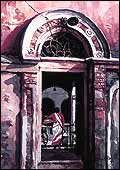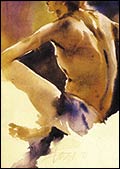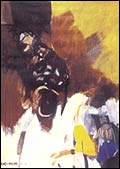 |
SANJAY BHATTACHARYYA
Woman Through THe Arch, 2001
Price of Bhattacharyya's watercolours in 1995: Rs 35,000
Price in 2001: Rs 1 lakh
Approx. Size: 22"x30" |
 |
PARESH MAITY
Life, 1991
Price of Maity's watercolours in 1995: Rs 18,000
Price in 2001: Rs 65,000
Approx. Size: 22"x30" |
It's
truly an existential dilemma for the wired age: Old Masters or New
Economy? Or N.S. Bendre or Hindustan Lever Limited (HLL)? Bendre,
for the uninitiated, was (he died in 1992) one of India's finest
painters-impressionism, cubism, pointillism, he did them all. At
today's rates, a Bendre would set you back by at least Rs 2 lakh.
That amount would have fetched you, on January 9, 2002, 900 shares
of HLL. A year back, the choice would have been a no-brainer. Today,
many aren't so sure. Not convinced? It took auction house Osian's
portfolio analysis to convince us.
Osian's exercise was built around two portfolios-of
paintings sold in 1997 and 1999-and measuring how each had appreciated.
The '97 portfolio appreciated 31.28 per cent over three years; the
'99 one by 57.44 per cent over a year. In the corresponding time-frames,
the Sensex depreciated by 8.9 per cent and 7.33 per cent.
Art is attracting more new buyers. ''Thanks
to the increase in disposable incomes and exposure to art, people
are showing more interest,'' says Pravina Mecklai, the owner of
Mumbai's Jamal Art Gallery.
 |
CHITTROVANU MAZUMDAR
Untitled, 1993-94
Price of Mazumdar's canvases in 1995: Rs 40,000
Price in 2001: Rs 80,000
Approx. Size: 5 ftx3ft |
 |
ANJU DODIA
The Magician, 1991
Price of Dodia's watercolours in 1996: Rs 18,000
Price in 2001: Rs 40,000
Approx. Size: 22"x30" |
Shalene and Salil Parekh are part of this smart
set. She works for an NGO and he manages the India office of Cap
Gemini Ernst & Young. ''We've sold some paintings at double
the price we acquired them for,'' says Shalene, ''and bought other
paintings with the money.'' The Springwalas, Kalpana and Zoeb, who
run a garment export business in Mumbai, go further and say they
believe in selling art and investing in other avenues, if they look
better. And ask Vyshaley Thacker, an executive in a foreign bank,
why she bought a Satish Gujral painting and she says something about
''portfolio diversification''.
More Buyers, More Sellers, More Everything
The result of this mini-boom is evident. ''The
market has grown wider,'' says Mallika Sagar, the India representative
of Christies. ''And people aren't just buying the top names.'' The
number of galleries in Delhi and Mumbai has zoomed. Mumbai has 80-odd
galleries, Delhi, 150. ''Prices of art have risen exponentially,
making people look at it as an investment,'' says Minal Vazirani,
the director of Saffronart, an art auction company.
So, has the art market come of age? Not quite,
say the experts. ''The art market today is like the stockmarket
was before SEBI was born and research became a way of life,'' explains
Neville Tuli, Chairman, Osian's. Some auction houses (Osian's included)
can lay claim to the research bit though. Some even publish regular
price lists that help individuals track how their investments are
doing.
Sangita Kathiawada, the owner of Mumbai's Melange
boutique, swears by such data. ''Art is a serious investment. Till
a few years ago, I wasn't aware that a painting that gives me pleasure
could double my money.''
-with inputs from Moinak Mitra
|
THE ART OF THE PICK
|
| Lest Kathiawada's quote motivates you to
liquidate your holdings in the stockmarket and head for the
nearest gallery, there are several caveats that accompany investing
in art. Here they are, laid out in the form of a simple catechism:
What do I need to have to invest in art?
It isn't money for sure: these days you can start your portfolio
with as little as Rs 10,000. The only pre-requisite is an
eye for art. George Mathews, the Consul General for Norway
in Mumbai, and his wife Meenakshi have, over the past 20 years
built a collection of over 50 paintings-on the basis of nothing
but their own instincts. ''Some of our possessions have appreciated
over 20 times,'' says Meenakshi.
Apart from quality what do I look for in a painting?
In one word, scarcity. It could be the work of an artist
who is now dead. Or it could belong to the very few paintings
of a theme the artist was taken up with in the past. Or it
could be a rare sale from a renowned collector's collection.
How long do I have to wait for my investment to mature?
Thanks to the huge number of galleries that have sprung
up, liquidity isn't really an issue. But an investor has to
acquire the patience to wait for at least four-to-five years.
''For the novice investor, new artists are the best bet,''
says Ashish Balram Nagpal, who owns the Mumbai Gallery Of
Art. ''There is less risk associated with them, and appreciation
has no end if you choose the right artist.''
Circa 2002, if I set out with Rs 10,000-Rs 20,000 what
kind of appreciation can I expect?
There are several artists whose work retails between
Rs 5,000 and Rs 10,000 apiece. According to Hema Singh of
the Delhi-based gallery Art Today (part of the India Today
Group that owns Business Today): ''Investing in newer upcoming
artist could yield an appreciation of around 50 per cent within
five years.''
Is there anything else I need to know about investing
in art?
Yes. Visit several galleries before buying a piece. If
you have the choice of either buying the best work of a new
artist or a mediocre offering from a master, pick the former
every time. And once you pick up a couple of paintings by
an upcoming artist, check out how his works appreciate over
a period of time. If the prices improve, evaluate increasing
your exposure.
|
|

